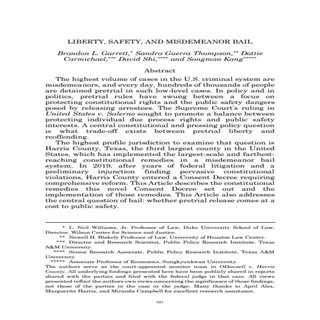Brandon L. Garrett, Sandra Guerra Thompson, Dottie Carmichael, David Shil & Songman Kang
The highest volume of cases in the U.S. criminal system are misdemeanors, and every day, hundreds of thousands of people are detained pretrial in such low-level cases. In policy and in politics, pretrial rules have swung between a focus on protecting constitutional rights and the public safety dangers posed by releasing arrestees. The Supreme Court’s ruling in United States v. Salerno sought to promote a balance between protecting individual due process rights and public safety interests. A central constitutional and pressing policy question is what trade-off exists between pretrial liberty and reoffending. The highest profile jurisdiction to examine that question is Harris County, Texas, the third largest county in the United States, which has implemented the largest-scale and farthest reaching constitutional remedies in a misdemeanor bail system. In 2019, after years of federal litigation and a preliminary injunction finding pervasive constitutional violations, Harris County entered a Consent Decree requiring comprehensive reform. This Article describes the constitutional remedies this novel Consent Decree set out and the implementation of those remedies. This Article also addresses the central question of bail: whether pretrial release comes at a cost to public safety.
We find that the constitutional rights protections of the Consent Decree appear largely successful in that people are now promptly freed in misdemeanor cases without the requirement that they pay cash bail. More surprising, perhaps, we find that public safety has also powerfully benefited. We describe a steady decline in the numbers of both misdemeanor arrests and rearrests. Few could have predicted with any certainty what the results of this large-scale bail reform would be. The result suggests there is no necessary trade-off between constitutional rights and public safety. These findings have powerful implications for rethinking the structure and application of the Salerno balancing test and for jurisdictions considering wholesale bail reform.









